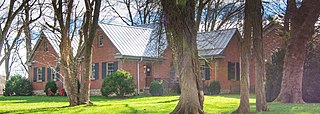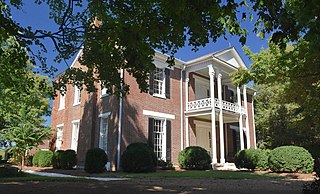This is a list of properties and historic districts in Tennessee that are listed on the National Register of Historic Places. There are over 2,000 in total. Of these, 29 are National Historic Landmarks. Each of Tennessee's 95 counties has at least one listing.
This is a list of the National Register of Historic Places listings in Knox County, Tennessee.

Tipton-Haynes State Historic Site, known also as Tipton-Haynes House, is a Tennessee State Historic Site located at 2620 South Roan Street in Johnson City, Tennessee. It includes a house originally built in 1784 by Colonel John Tipton, and 10 other buildings, including a smokehouse, pigsty, loom house, still house, springhouse, log barn and corncrib. There is also the home of George Haynes, a Haynes family slave.

Travellers Rest is a historic plantation house in Nashville, Tennessee.
This is a list of the National Register of Historic Places listings in Blount County, Tennessee.

The Magevney House is a historic residence on 198 Adams Avenue in Memphis, Tennessee, USA. It is located in the Victorian Village of Memphis and is listed on the National Register of Historic Places. It is one of the oldest residences remaining in Memphis.
This is a list of the National Register of Historic Places listings in Williamson County, Tennessee.

Milky Way Farm in Giles County, Tennessee, is the former estate of Franklin C. Mars, founder of Mars Candies. The property is named for the company's Milky Way candy bar. During the Great Depression, the estate was the largest employer in Giles county. The estate is listed on the National Register of Historic Places as an historic district; the farm and manor house are now used for weddings, tours, trail runs, & special events.

Smithson–McCall Farm is a 256.3-acre (103.7 ha) historic district in Bethesda, Tennessee. The farm was listed under the National Register of Historic Places in 2007. The listing claims that the property "documents the impact of the progressive agricultural movement of the early twentieth century on the operations and landscape of a middle-class family farm," and includes an "architecturally significant group of buildings and structures, placed within an agricultural landscape of high integrity...that represents a good example of farmstead architecture in Middle Tennessee and that reflects the impact of the Progressive Farm movement of the early twentieth century".

Bethesda, Tennessee is an unincorporated community in rural southeastern Williamson County, Tennessee.

The William Boyd House, also known as All Bright Hill, is a circa 1800 double-pen house in Franklin, Tennessee, United States.

The Boyd–Wilson Farm is a 157-acre (64 ha) historic district in Franklin, Tennessee, United States. The circa 1840 farm includes an I-house.

The Robert Hodge House, also known as Sullivan Farm House, is a ca. 1900 Queen Anne and Colonial Revival house in Franklin, Tennessee.

The John Crafton House is a historic property in Franklin, Tennessee, United States, that was listed on the National Register of Historic Places on April 13, 1988.

The Samuel B. Lee House, also known as Maplewood, is a house in Duplex, in the U.S. state of Tennessee that was listed on the National Register of Historic Places in 1988. The listed area was increased from 72 to 398 acres and the property listing name was changed to Maplewood Farm 1993.

The Samuel F. Glass House is a property in Franklin, Tennessee that dates from 1859. It was listed on the National Register of Historic Places in 1988. It has also been known as Pleasant View.

The Lamb–Stephens House is a property in Franklin, Tennessee that dates from c. 1820. It was listed on the National Register of Historic Places from 1988 until 2011.

Harlinsdale Farm is a 198-acre (80 ha) historic district in Franklin, Tennessee that was listed on the National Register of Historic Places in 2006. It dates from c.1900 and had other significant dates in 1935 and 1945.

The James P. Johnson House is a building and property in Thompsons Station, Tennessee, dating from 1854. It has been listed on the National Register of Historic Places since 1988. It has also been known as Laurel Hill. It includes Greek Revival and Central passage plan and other architecture.

The Maple Dean Farm is a historic farmhouse in Shelbyville, Tennessee, U.S.. Built in 1886 on a farm established in 1819, it was designed in the Eastlake architectural style. It became a century farm in 1976, and it was listed on the National Register of Historic Places in 1976.












